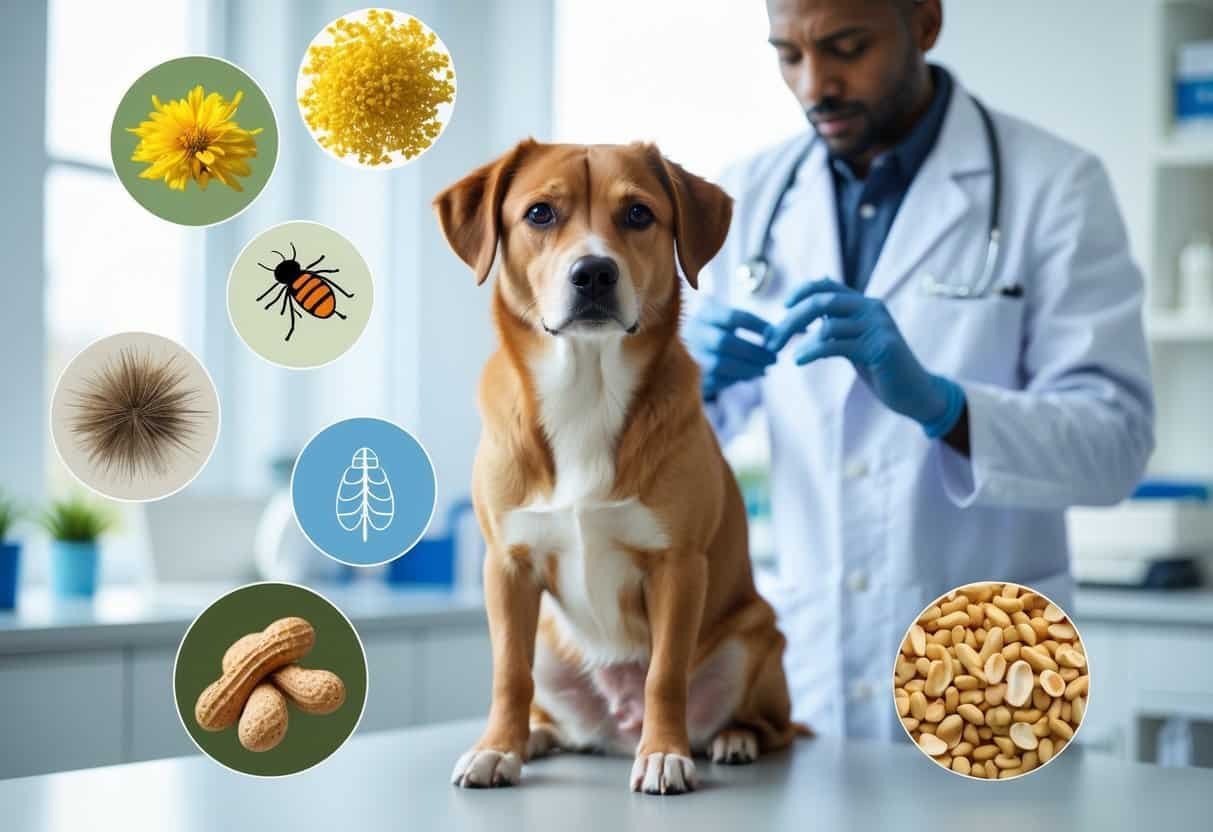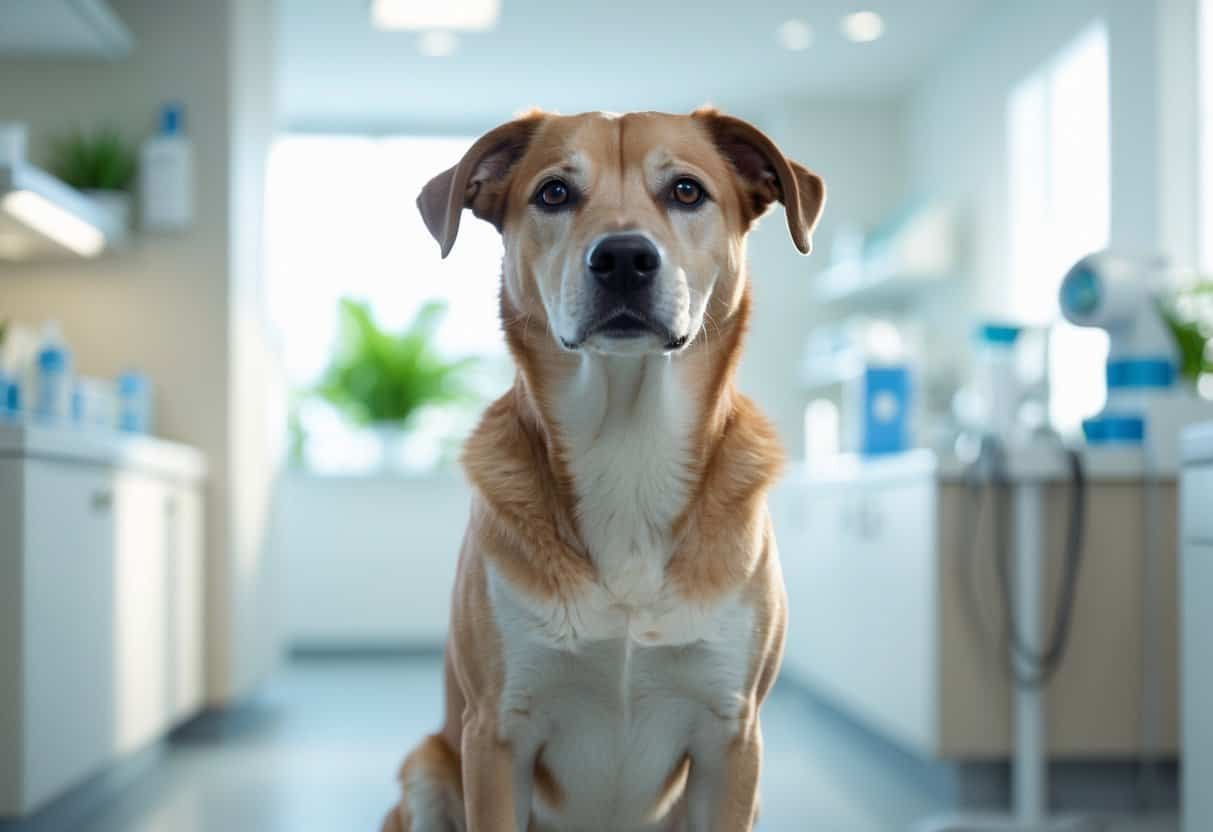
Types Of Canine Allergies

Dogs can get allergies from a bunch of things—flea bites, certain foods, or stuff in their environment. Most of the time, allergies show up as skin problems, itching, or stomach issues.
Flea Or Insect Bite Allergies
Flea allergy dermatitis is a top skin problem for dogs. When a flea bites, it injects saliva into the skin, and some dogs get super sensitive, itching like crazy even from just one or two bites.
They’ll chew, lick, and scratch, mostly around the tail base, thighs, and belly. Dogs with flea allergies often lose hair in those spots, and their skin might turn red, scabby, or even get infected.
Stopping flea bites is key, so use flea control treatments regularly. Check for fleas with a fine-tooth comb, and don’t forget to treat your home if you spot them.
Other insect bites—think mosquitoes or mites—can also set off allergies in some dogs, but it’s not as common as flea issues.
Atopic Dermatitis
Atopic dermatitis comes from environmental allergies, or atopy. Dogs with this problem react to pollen, mold, dust mites, or grass.
It’s genetic and usually pops up before age three, but honestly, it can show up anytime. Most dogs itch, chew their feet, rub their faces, or get ear infections.
These symptoms might stick around all year or just show up during certain seasons. Managing atopic dermatitis can get tricky, and dogs often need meds, special shampoos, or even allergy shots to keep things under control.
Environmental allergies don’t spread from dog to dog and often stick around for life, so you’ll probably need to keep up care long-term.
Food Allergies
Food allergies aren’t as common as environmental ones, but they can still cause big problems. Dogs can react to proteins in their food—beef, chicken, dairy, or even some grains.
Usually, you’ll see itchy skin, ear infections, or tummy troubles like vomiting or diarrhea. Sometimes, it takes months of eating the same food before you notice anything.
Diagnosing food allergies usually means a diet trial with limited-ingredient or hydrolyzed protein food for several weeks. If your dog reacts, you’ll need to avoid those foods for good.
More info about food allergies can help if you’re thinking about switching up your dog’s diet.
Contact Allergies
Contact allergies aren’t super common, but they happen. These show up when a dog’s skin touches something irritating—like certain shampoos, cleaning stuff, flea collars, grass, or bedding.
You’ll usually see redness, swelling, or little bumps on spots with less hair, like the feet, belly, or groin. The best fix is to find and ditch whatever’s causing the problem.
Sometimes, a vet might suggest allergy testing or meds to help your dog feel better. Keeping track of new things in your dog’s environment can make it easier to figure out what’s wrong. For a more detailed look at canine allergies, check out this guide.
Common Triggers Of Allergies In Dogs
Dogs can react to all sorts of things. The biggest culprits are usually stuff in the environment, certain foods, and chemicals or products around the house.
Environmental Allergens
Environmental allergens are things like pollen, dust mites, mold, and dander. These can float around outside or hang out inside your house.
Lots of dogs get allergic reactions during high-pollen seasons. Grass, weeds, and trees are big sources of pollen that bug some dogs.
Dust mites love carpets, bedding, and couches. Mold can grow in damp spots around the house.
Allergies from these things usually make dogs itch, lick their paws, or get red skin—especially on the face, ears, and paws. Sometimes, the symptoms come and go with the seasons, but if the allergens stick around, so do the problems.
More about environmental triggers is over at this page on allergies in dogs.
Specific Food Ingredients
Some foods trigger allergies in dogs—beef, chicken, dairy, wheat, eggs, and soy are the usual suspects. Not every dog reacts to the same things, and sometimes it takes a while for symptoms to show up.
Food allergies usually cause itchy skin, ear infections, or stomach issues like vomiting and diarrhea. Flea saliva can also trigger reactions if the dog gets bitten.
Food allergies don’t care about the season—they can happen anytime. Figuring it out often means cutting out foods one by one. For more details, see the talk about food allergies in dogs.
Household Materials And Chemicals
Everyday stuff at home can set off allergies—cleaners, laundry detergents, air fresheners, and even some pet shampoos. Some of these products have ingredients that just don’t agree with sensitive dogs.
You might notice skin irritation, paw licking, or sneezing. Sometimes, the reaction happens after walking on a freshly cleaned floor or sleeping on bedding washed in scented detergent.
Keeping dogs away from strong-smelling or chemical-heavy products can really help. Want more info? Here’s a good resource on household allergens in dogs.
Recognizing Symptoms Of Allergies In Dogs
Allergic dogs often scratch nonstop, develop red skin patches, break out in hives, or—rarely—swell up badly. Watching for these signs helps you catch problems early and get your dog the care it needs.
Itching And Scratching
Persistent itching is probably the number-one allergy sign in dogs. You’ll see them scratching, chewing their paws, or licking the same spots again and again.
This can lead to broken skin, bald patches, or sores. Itchy skin isn’t just annoying—it can mess with a dog’s sleep and mood.
Some dogs rub their faces on the carpet or furniture, just trying to get relief. Too much ear scratching can lead to ear infections. You’ll notice head shaking, a bad smell, or discharge.
If ear infections keep coming back, allergies might be to blame. Check out PetMD’s page on dog allergy symptoms for more info.
Redness And Irritation
Allergies often make dogs’ skin red and inflamed. It can show up anywhere, but the belly, paws, and inside the ears are common spots.
The skin might look swollen or feel warm. Dogs will sometimes chew or lick these areas, making things worse and sometimes causing open sores or infections like pyoderma.
Chronic skin infections are a big clue your dog has allergies. Inflamed ears can also turn red and swollen. If you leave it alone, irritation can get painful and lead to more ear infections.
The Animal Humane Society has good advice about redness and skin problems in dogs with allergies.
Hives (Urticaria)
Hives, or urticaria, look like raised, itchy bumps that pop up fast during an allergic reaction. You’ll usually spot them on the face, belly, or legs, but honestly, they can appear anywhere.
Hives really stand out on short-haired dogs. The bumps might be small or form bigger patches, and hair can fall out where the dog scratches or rubs.
Swelling often goes with hives, especially around the eyes and snout. Hives are a red flag—if they don’t fade quickly, or your dog struggles to breathe, get to a vet. For more about hives and skin changes, check the section on dog allergy signs.
Severe Reactions: Edema And Anaphylactic Shock
Most allergy symptoms are mild, but sometimes dogs have severe reactions. Edema is sudden swelling, usually on the face, lips, or throat. It can make it hard for your dog to see or even breathe.
Anaphylactic shock is rare but super serious. It might start with vomiting, diarrhea, or collapsing. The dog’s heart might race, gums turn pale, breathing gets tough, or they might even pass out.
Both edema and anaphylactic shock are emergencies. If your dog shows these signs, get to a vet right away. VCA Animal Hospitals has a guide with more on serious allergic reactions in dogs.
Quick Facts Table: Severe Allergy Signs
| Sign | What to Look For |
|---|---|
| Edema | Swelling around face/throat |
| Anaphylactic Shock | Collapse, breathing trouble |
| Sudden Hives | Raised bumps, swelling |
| Severe Vomiting | More than once, sudden |
Diagnosing Canine Allergies
To diagnose allergies in dogs, vets start with a clinical exam and then run some specific tests. This helps figure out what’s setting off your dog’s immune system and lets you create a treatment plan that actually works for your pup.
Role Of Veterinarians
Veterinarians start by gathering a detailed medical history. They ask about symptoms, timing, and possible exposures.
Common signs include itching, redness, hair loss, frequent ear infections, or stomach problems. A physical exam checks for patterns and severity of symptoms.
Vets often rule out other causes like infections, fleas, or skin diseases. They look for signs that a dog’s immune system is overreacting to everyday things in the environment.
They guide owners through treatment options. With their expertise, they help choose the right tests and decide if home care or an allergy specialist is needed.
Allergy Testing Methods
There are a few main ways to test for allergies in dogs. One common approach is through blood tests like the RAST test.
This test measures how the dog’s immune system reacts to different allergens in the blood. Blood testing is less invasive but sometimes delivers mixed results for certain allergies.
Another method is intradermal skin testing. The vet injects small amounts of different allergens under the skin and watches for a reaction.
This test is often used for environmental allergies but isn’t used for food allergies. Food allergies are usually diagnosed with an elimination diet trial.
The dog eats a special diet for at least 8 weeks, and symptoms are monitored for improvement. More details on these methods are at VCA Animal Hospitals and Merck Veterinary Manual.
Identifying Specific Allergens
Figuring out exactly what a dog is allergic to can be tricky. Vets use blood or skin testing to check for reactions to pollen, dust, mold, or mites.
Results help build a list of things to avoid or manage. For food allergies, only elimination diet trials can pinpoint triggers.
This process removes common ingredients and slowly reintroduces them to spot the cause. Some blood tests suggest food sensitivities, but they’re not as reliable as diet trials.
Allergen lists can include non-food items like cotton or nylon, so it’s worth considering the dog’s environment. Testing results help owners and vets make changes to reduce future reactions.
Treatment Options For Canine Allergies
Dogs with allergies need specific treatments to control itching and manage flare-ups. Common therapies include medication, bathing routines, and sometimes allergy shots to address both the cause and symptoms.
Anti-Inflammatory Therapies
Anti-inflammatory treatments quickly reduce swelling, itching, and redness in dogs with allergies. Corticosteroids like prednisone often provide fast relief.
They block the allergic response in a dog’s body, but long-term use can cause side effects like increased thirst, hunger, or infection risk. Other modern anti-inflammatory drugs, like Apoquel and Cytopoint, target specific pathways in the immune system.
Apoquel tablets control itching and inflammation within hours and are often chosen for chronic cases. Cytopoint is given as an injection and can provide relief for several weeks.
Short courses of steroids are used for severe flare-ups but aren’t considered safe for regular use. Veterinarians monitor dogs closely when using these therapies to minimize side effects.
Key drugs used:
| Medication Type | Common Examples |
|---|---|
| Corticosteroids | Prednisone, Dexamethasone |
| Non-steroid anti-inflammatory | Apoquel, Cytopoint |
Use Of Antihistamines
Antihistamines are frequently tried for dogs with mild allergies. These drugs block histamine, the chemical released during an allergic reaction that causes itching and swelling.
Common antihistamines for dogs include diphenhydramine (Benadryl), cetirizine, and loratadine. Some dogs respond well, while others may not see much benefit.
Side effects are usually mild, like drowsiness or dry mouth. Unlike steroids, antihistamines are considered safer for longer use and don’t suppress the immune system as much.
Antihistamines aren’t very effective for severe allergies but can be a good first step for mild symptoms or to reduce the need for stronger meds. Owners should talk to their vet before starting any new medicine.
Common over-the-counter antihistamines:
- Diphenhydramine (Benadryl)
- Cetirizine (Zyrtec)
- Loratadine (Claritin)
Specialized Shampoos
Regular use of specialized medicated shampoos helps manage dog allergies by washing away allergens and soothing irritated skin. Shampoo therapy often uses products designed to reduce itching and inflammation.
Some formulas contain oatmeal, aloe vera, or prescription-strength anti-itch ingredients. Frequent bathing, sometimes once or twice a week, can cut down on pollen, dust, or other allergens that stick to the dog’s coat.
This helps prevent skin infections and can reduce the number and severity of allergy flare-ups. Medicated shampoos should be chosen based on the dog’s needs.
Some are aimed at treating yeast or bacterial infections, which allergic dogs often get. Always follow veterinary advice on which shampoo to use and how often to bathe for best results.
More details about the benefits of bathing are at Itch Pet Vet’s article on treatment options for environmental allergies.
Benefits of medicated shampoos:
- Remove surface allergens
- Reduce skin inflammation
- Lower risk of infection
Immunotherapy
Immunotherapy aims to treat the root cause by training the dog’s immune system to tolerate specific allergens. This process, sometimes called hyposensitization, involves regular injections or oral drops with small amounts of the allergens the dog reacts to.
Over several months to a year, the dog’s immune system usually becomes less sensitive to the allergens. Many dogs end up with fewer symptoms and need less medication.
Immunotherapy is customized for each dog based on allergy testing and requires patience. Allergy shots are often recommended for dogs with moderate to severe symptoms that don’t respond well to other treatments.
They don’t work instantly, but when successful, immunotherapy can decrease the frequency and intensity of allergic reactions. More on this therapy is at PetMD’s page about dog seasonal allergies and treatment.
Key immunotherapy facts:
- Custom-designed for each dog
- Can reduce or eliminate need for drugs
- Takes months to reach full effect
Managing Environment And Lifestyle Changes
Itching, redness, and other allergy symptoms in dogs can often be improved by making specific changes in their environment and lifestyle. Small steps like cleaning, proper diet, and home care products can help control allergic reactions and boost comfort.
Reducing Allergen Exposure
To manage canine allergies, it’s important to limit contact with triggers like pollen, dust, and certain cleaning chemicals. After time outside, owners should wipe their dog’s paws, belly, and coat with a damp cloth or a pet-friendly wipe.
This removes pollen and dirt, helping to cut down on reactions. Using air filters and cleaning air ducts also keeps indoor air cleaner year-round.
Bathing the dog regularly with a hypoallergenic shampoo rinses away allergens trapped in fur and soothes irritated skin. For homes with carpets, frequent vacuuming and using washable bedding helps control dust and dander.
Controlling fleas is also critical since flea bites can trigger or worsen allergies. Using a vet-recommended flea prevention program and cleaning pet bedding reduces the risk of flea-related reactions.
Dietary Adjustments
Changing a dog’s diet can provide major relief from allergy symptoms. For dogs with possible food allergies, an elimination diet—removing suspected proteins and then reintroducing them one at a time—helps find the cause.
Some dogs do best on a hypoallergenic diet with limited, novel protein sources and grain-free formulas. Adding fatty acid supplements, especially omega-3s, can help reduce inflammation and itchiness from allergies.
Quality of life improves if the dog’s diet supports healthy skin and fur. Fresh or raw diets may also benefit some pets, but owners should only make big dietary changes with a veterinarian’s help.
Keeping clean water available and avoiding table scraps or unfamiliar treats is important to limit extra allergens.
Using Home Remedies
Some simple home remedies can help with canine allergies. Owners can use gentle oatmeal baths to calm itchy skin.
Cool, damp cloths applied to red or irritated areas can offer quick relief between baths. Soothing paw soaks, especially after walks, help wash away allergens and decrease licking or chewing.
It’s best to avoid using human creams or medications on pets. Instead, use pet-safe products approved by a veterinarian.
Consistent routines—like cleaning paws, regular grooming, and keeping living areas tidy—support a dog’s comfort and lessen allergy flares. More tips on managing pet allergens are at VCA Animal Hospitals and Laguna Beach Vet.
Understanding Seasonal Allergies In Dogs

Dogs often show clear signs when they have seasonal allergies. Their symptoms are usually linked to changes in the environment, like higher pollen or mold levels.
Seasonal allergies can affect a dog’s comfort, skin, and quality of life.
Manifestation Of Seasonal Allergies
Seasonal allergies in dogs usually pop up in the spring, summer, or fall. Pollen from trees, grasses, and weeds tend to be the main triggers.
Mold spores and other outdoor allergens can also set things off.
Key signs include:
- Frequent itching or scratching
- Red or inflamed skin
- Excessive paw licking or chewing
- Shedding more hair than usual
- Biting at their coat
Some dogs get skin infections if allergies go unchecked. If you notice compulsive paw licking and red spots, it’s probably bothering them.
These problems usually stand out more after your dog spends time outside.
Specific Treatments For Seasonal Allergies
Treatments aim to ease itching and stop bigger problems. Many vets suggest frequent baths with hypoallergenic shampoos to wash allergens off your dog’s skin and fur.
Antihistamines or vet-prescribed steroids can help with tough cases of itching. For some dogs, allergy shots (immunotherapy) might help train their immune system not to freak out.
Try keeping your dog inside when pollen counts are high. Wiping their paws after walks can cut down on allergen exposure.
Vets might also recommend topical creams for red or infected skin. If your dog loses hair or gets a skin infection, you might need antibiotics or more advanced treatment.
Your vet can help you figure out the best plan based on your dog’s symptoms and what seems to set them off. You can find more about treatments and signs for seasonal allergies in dogs online.
Frequently Asked Questions

Allergies in dogs can show up as itchy skin, ear issues, or stomach trouble. Treatment depends on the allergy, but might involve medication, changing food, or steering clear of certain triggers.
What are the typical symptoms of allergies in dogs?
Dogs with allergies often get itchy or red skin. Some get ear infections, lick their paws, or lose fur.
If food is the problem, you might see vomiting or diarrhea. Sometimes, allergies cause sneezing or breathing issues too.
How are canine allergies commonly treated?
Vets might prescribe antihistamines, steroids, or medicated shampoos for allergies in dogs. For food allergies, switching to a special diet is pretty common.
Avoiding known triggers like certain plants or foods can really help. Allergy shots are an option for some dogs with ongoing problems.
What are the different types of allergies that can affect dogs?
Dogs can get food allergies, environmental allergies, and flea allergies. Food allergies usually come from proteins like beef or chicken.
Environmental allergies might be from pollen, dust mites, or mold. Flea allergy dermatitis comes from flea bites.
What are the usual treatments for skin allergies in dogs?
Treatment for skin allergies often means medicated baths or topical creams. Vets sometimes use oral meds or allergy shots too.
Removing the allergen—like changing food or using flea prevention—can make a big difference.
How can humans manage allergy symptoms caused by dogs?
If you have pet allergies, keep your home clean and vacuum a lot. Air purifiers can help get pet dander out of the air.
Regularly bathing and grooming the dog might lower allergens at home. Some folks also keep dogs out of bedrooms or other rooms to help with symptoms.
Are seasonal allergies a concern for dogs, and what are the signs?
Seasonal allergies are common in dogs.
You’ll often see signs like itchiness, face rubbing, sneezing, and watery eyes. Some dogs chew their paws or get red skin, especially when pollen’s floating around.


